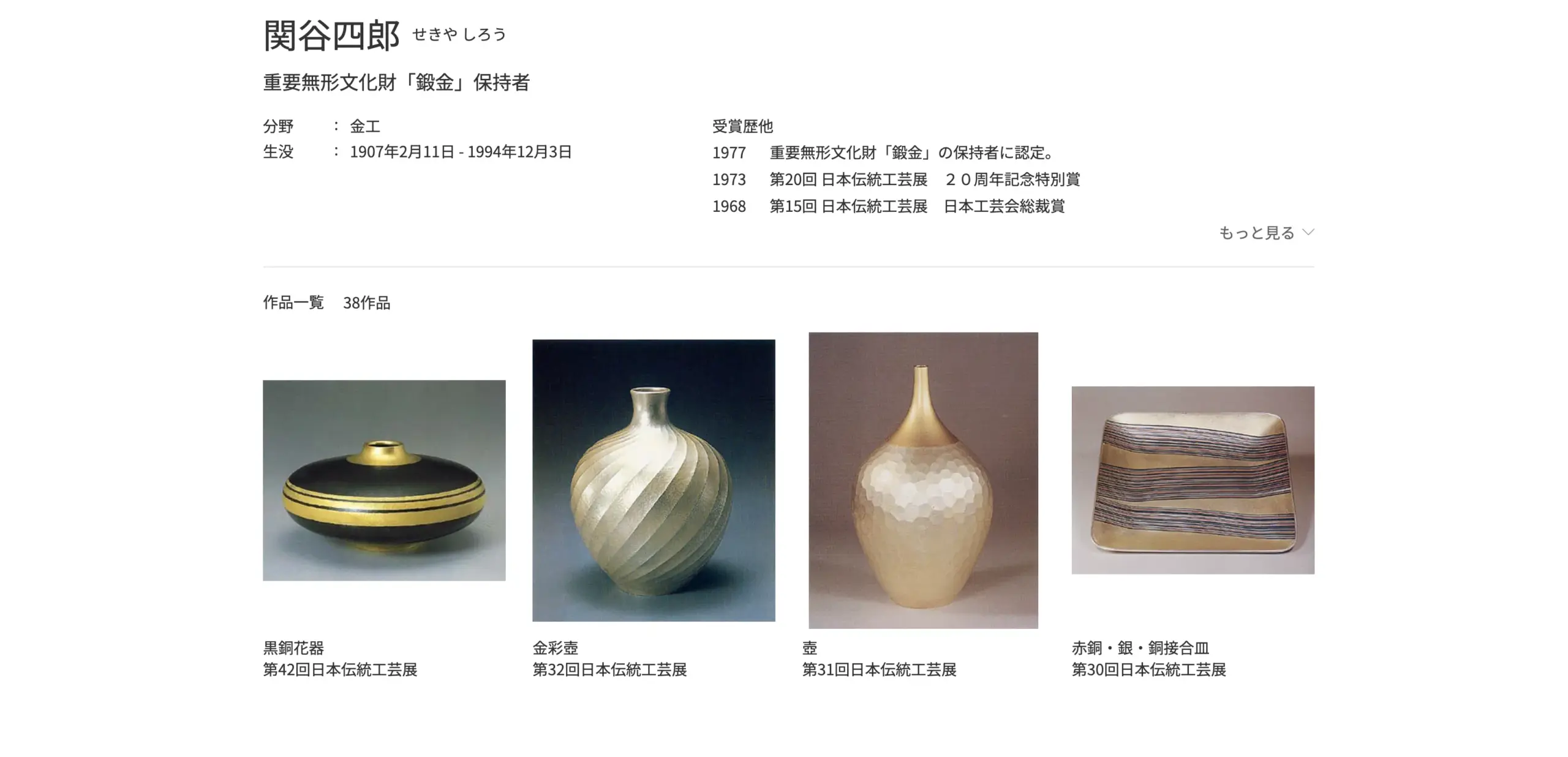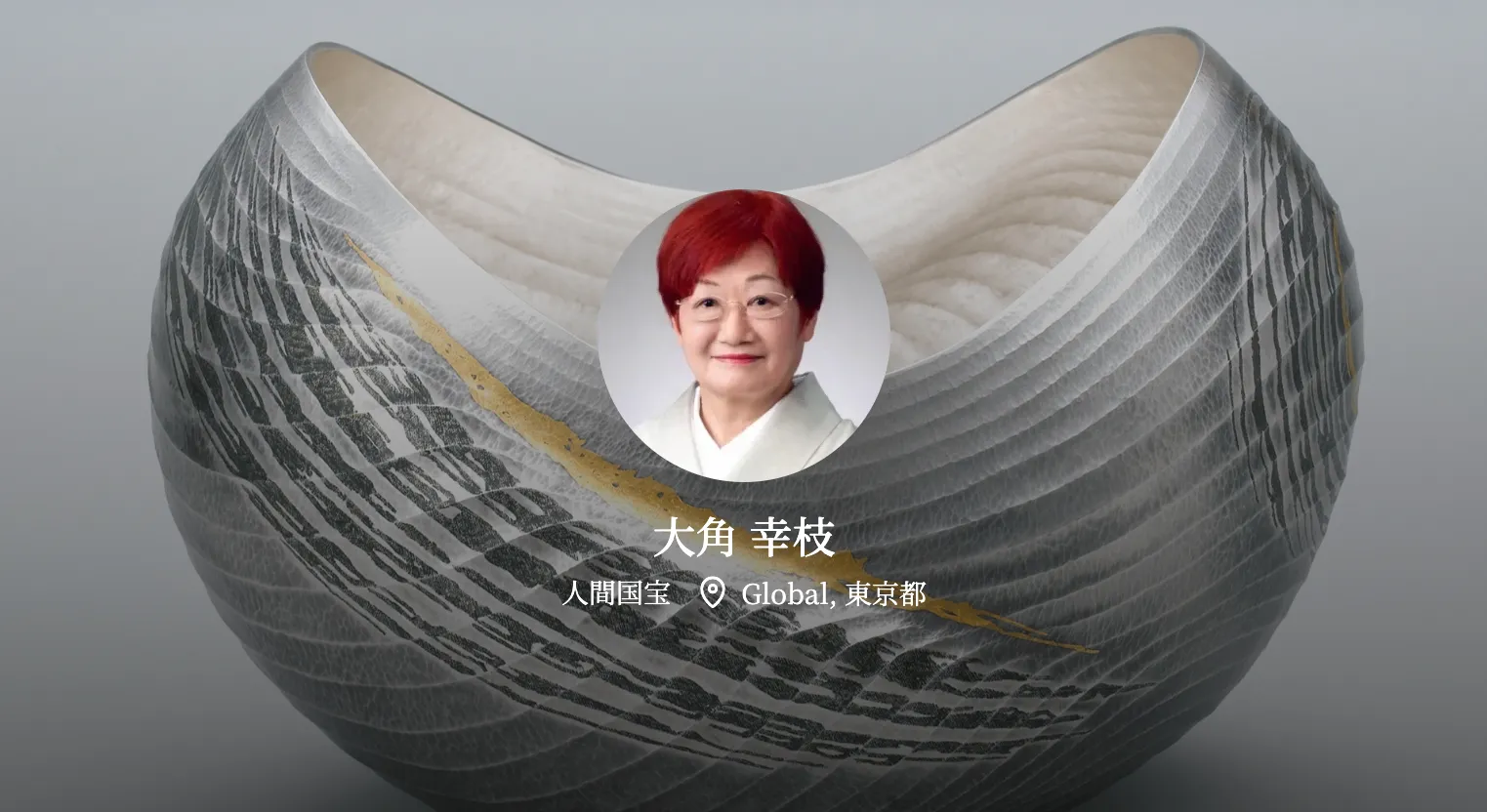Yukie Osumi is the first woman in Japan’s metal craft field to be designated as a Living National Treasure for “tankin” (forging metal).
In the world of tankin, where metals such as copper and silver are hammered and shaped, she has established a unique style that combines both softness and strength.
Behind this achievement lies her lineage and educational journey, and through numerous masterpieces, she has opened new horizons in Japanese metalwork.
However, to properly understand her accomplishments and the appeal of her works, it’s essential to know the characteristics of her style, her lineage, and her representative works. This article provides a detailed explanation of Yukie Osumi’s profile and artistic world.
Table of Contents
Who is Yukie Osumi?
Yukie Osumi (born 1945) is an artist representing Japanese metalwork and is known as a holder of Important Intangible Cultural Property “tankin” (forging metal).
Born in Kakegawa City, Shizuoka Prefecture, after studying at Tokyo University of the Arts, she began walking the path of tankin in earnest.
While mastering the tankin technique of hammering thin metal plates to shape and decorate them, she has developed forms that incorporate contemporary sensibilities.
Her works inherit craft traditions while presenting new beauty, earning high acclaim both domestically and internationally.
Furthermore, she has devoted herself to education and nurturing the next generation, leading the Japan Kogei Association for many years.
Here, we’ll introduce her educational background, designated field, and major awards.
Born 1945 in Kakegawa, Shizuoka Prefecture / Education at Tokyo University of the Arts
Yukie Osumi was born in Kakegawa City, Shizuoka Prefecture in 1945. From childhood, she had an interest in handwork and art, eventually discovering the appeal of metalwork crafts.
She chose Tokyo University of the Arts, the pinnacle of art education in Japan, majoring in Art Studies at the Faculty of Fine Arts and graduating in 1969.
After graduation, she studied under Ikkoku Kashima, Shiro Sekiya, and Moriyuki Katsura, thoroughly mastering the fundamentals of tankin technique and aspiring to become an artist.
The experience cultivated through university education and instruction from her masters became the core of her subsequent creative activities, resulting in a unique style that balances the delicacy and strength of tankin.
Her education at Tokyo University of the Arts and subsequent training can be said to be the period that built a solid foundation for Yukie Osumi to emerge in Japan’s metalwork world.
Designated Field: Reaching the Pinnacle of Important Intangible Cultural Property “Tankin” (Forging Metal)
Yukie Osumi has been active in the tankin field for many years, and as the culmination of this, she was designated as a holder of Important Intangible Cultural Property (Living National Treasure) in 2015.
Tankin is a technique of hammering metal plates to shape them, an advanced craft technique capable of expressing warmth and softness beyond the coldness inherent in metal.
Yukie Osumi’s works are characterized by their fusion of traditional technical precision with contemporary sculptural sensibility.
From flower vases and tea ceremony utensils to abstract objects, her diverse body of work maximizes the texture and luster of metal, providing viewers with new sensations.
Yukie Osumi’s journey demonstrates a path to connect the traditional field of tankin to the next generation, holding great significance in craft history.
Major Honors: Medal with Purple Ribbon, Order of the Rising Sun, Gold and Silver Rays, and Japan Traditional Kōgei Exhibition Awards
Yukie Osumi has repeatedly won selections and awards at the Japan Traditional Kōgei Exhibition, including the Imperial Prize in 1987, establishing her position as a leading figure in the metalwork field.
Furthermore, in 2010, she received the Medal with Purple Ribbon for her long-standing contributions to cultural activities, and in 2017, she was awarded the Order of the Rising Sun, Gold and Silver Rays.
These honors demonstrate that Yukie Osumi’s creative activities transcended the framework of personal art and contributed to Japanese culture as a whole.
Her abundant awards are evidence that her technical skill and expressive power have been highly valued both domestically and internationally, showing that Yukie Osumi’s presence has contributed to the development of Japan’s craft world. These achievements will continue to be passed down as a model for future generations.
The Core of Her Style and Techniques — The Trinity of Tankin × Chōkin × Nunome-Zōgan
Yukie Osumi’s artistic style lies in comprehensive metalwork expression that fuses chōkin (metal engraving) and nunome-zōgan (textile-pattern inlay) while based on traditional tankin.
By combining tankin, which shapes forms by hammering base metal, chōkin, which adds carving to details to emphasize shadows, and nunome-zōgan, which inlays gold, silver, lead, and platinum, in a trinity, she has achieved rich texture and three-dimensionality unlike any other.
The ability to express soft waves and flowing clouds beyond the hardness of metal demonstrates Yukie Osumi’s uniqueness, pushing traditional metalwork into new territory.
Here, we’ll introduce in detail the aesthetic of nunome-zōgan, the sculptural beauty of vessel forms, and representative works with their collection locations.
The Aesthetic of Nunome-Zōgan: The Radiance Woven by Gold, Silver, Lead, and Platinum
Essential to Yukie Osumi’s works is the nunome-zōgan technique. This involves carving fine textile-pattern grooves on the surface of the base metal and embedding different metals such as gold, silver, lead, and platinum into them.
The textile-pattern carving must be fine and uniform, and its precision determines the brilliance and adhesion of the inlaid metals.
Yukie Osumi masters this technique, controlling the subtle reflections between metals to express depth and color that cannot be achieved with a single metal.
Particularly, nunome-zōgan, whose brilliance changes depending on light sources, resonates with designs reflecting natural transitions, constantly giving viewers new impressions.
Through such meticulous work, Yukie Osumi has brought pictorial expressiveness to metalwork, establishing artistry that transcends craft.
The Sculptural Beauty of Vessel Forms: Depicting “Waves, Clouds, Wind” Through Ridgelines, Volume, and Base Metal Color
Yukie Osumi’s tankin works feature sculptural beauty where the vessel form itself symbolizes the forces of nature.
They are characterized by skillfully utilizing the sharpness of ridgelines and the volume of base metal to abstractly depict the undulation of waves, the drift of clouds, and the flow of wind.
In the tankin process of hammering copper and silver, she pursued the tension and tautness of surfaces and curves while balancing thinness with strength.
Furthermore, she directly incorporated the reddish-copper and silvery-white colors of the base metal into the design, creating dynamic expression through contrast with the metallic colors of nunome-zōgan.
The vessel forms exist not as mere containers but as symbolic entities that shape natural phenomena, evoking in viewers the expanse of atmosphere and water.
Yukie Osumi’s works can be said to perform a “poetry of nature” in metal, transcending the framework of traditional crafts.
Representative Works and Collection Locations: Silver Hammered Flower Vase “Ōshio” and Others / Major Domestic and International Museums
One of Yukie Osumi’s representative works is the flower vase “Ōshio” (Great Tide), created in 2023 through silver hammering.
This work, which symbolically shapes the power of the sea where waves advance and recede, radiates a powerful presence through the unity of tankin’s thickness and the play of light from nunome-zōgan.
Her other works also center on nature as their theme, building a unique worldview through the fusion of minute inlay patterns carved on metal surfaces with sculptural forms.
Yukie Osumi’s works have received high acclaim through the Japan Traditional Kōgei Exhibition and solo exhibitions, and are collected domestically at institutions such as the National Museum of Modern Art, Crafts Gallery, and internationally at the Victoria and Albert Museum (London), Metropolitan Museum of Art (New York), and Smithsonian National Museum of Asian Art (Washington D.C.).
This body of work occupies a firm position in contemporary craft history as achievement that elevated tankin technique to the artistic realm.
Lineage and Career Turning Points
Yukie Osumi’s journey has been shaped by techniques inherited from her masters and career turning points she forged herself.
The starting point was learning traditional tankin techniques from metalwork masters Ikkoku Kashima, Shiro Sekiya, and Moriyuki Katsura, thoroughly mastering these fundamentals.
Furthermore, awards and recognition at the Japan Traditional Kōgei Exhibition increased her national prominence, and overseas training experiences provided new perspectives to her style.
Then in 2015, she achieved the remarkable feat of becoming the first woman designated as a holder of Important Intangible Cultural Property “tankin” (forging metal) in the metalwork field, solidifying her position. Here, we’ll delve into her lineage and education, domestic and international recognition, and the significance of holder designation.
Learning Metalwork Succession from Ikkoku Kashima, Shiro Sekiya, and Moriyuki Katsura
Ikkoku Kashima
After graduating from Tokyo University of the Arts, Faculty of Fine Arts, Art Studies Department in 1969, Yukie Osumi studied the fundamentals and expressive power of tankin from metalwork master Ikkoku Kashima.
Shiro Sekiya

From Shiro Sekiya, she learned meticulous craftsmanship and a thorough approach to sculptural beauty.
Moriyuki Katsura
From Moriyuki Katsura, she learned advanced decorative techniques including nunome-zōgan.
The teachings of these three masters became Yukie Osumi’s technical foundation and support for her subsequent unique expression.
Particularly, the minute work of nunome-zōgan became established at the core of her style as a signature expressive technique.
In addition to the solid foundation learned from her masters, by fusing her unique sensibility as a female artist, Yukie Osumi has created works that harmonize tradition and innovation.
Recognition at the Japan Traditional Kōgei Exhibition
Yukie Osumi has repeatedly achieved selections and awards at the Japan Traditional Kōgei Exhibition, establishing her reputation as a leading figure in the metalwork field.
Through this, she became deeply involved in the activities of the Japan Kogei Association, attracting attention as an artist who would carry the next generation.
Based on such domestic recognition and activities, Yukie Osumi continues the transmission of tankin techniques and exploration of new expression.
The Significance of 2015 Holder Designation: A Pioneering Achievement as the First Woman in the Metalwork Field
In 2015, Yukie Osumi was designated as a holder of Important Intangible Cultural Property “tankin” (forging metal).
This was a pioneering achievement as the first woman in Japan’s metalwork field, and an epoch-making event for the traditional craft world as a whole.
Until then, metalwork had long been considered a male-centered world, but Yukie Osumi’s designation can be said to be proof that technical skill and artistic quality were properly evaluated beyond gender.
Additionally, it became great encouragement for female artists of future generations, opening new paths in the craft world.
Holder designation is not merely personal honor but demonstrates the expansion of diversity in the future of metalwork and new possibilities for technical transmission.
Yukie Osumi’s presence continues to attract high attention even today as an existence that protects craft traditions while holding social significance.
Conclusion
Yukie Osumi has created works that give metal vitality and poetic sentiment by freely manipulating tankin, chōkin, and nunome-zōgan.
Based on the solid foundation learned from Ikkoku Kashima, Shiro Sekiya, and Moriyuki Katsura, she was highly acclaimed at the Japan Traditional Kōgei Exhibition.
In 2015, she was designated as the first female holder of Important Intangible Cultural Property “tankin” (forging metal), and her journey can be said to have opened new paths in the traditional craft world.
Her representative works are collected in museums both domestically and internationally, continuing to move many people today.
Yukie Osumi’s presence is a symbol of contemporary craft that inherits tradition while layering innovation, serving as a great guide for future generations.



